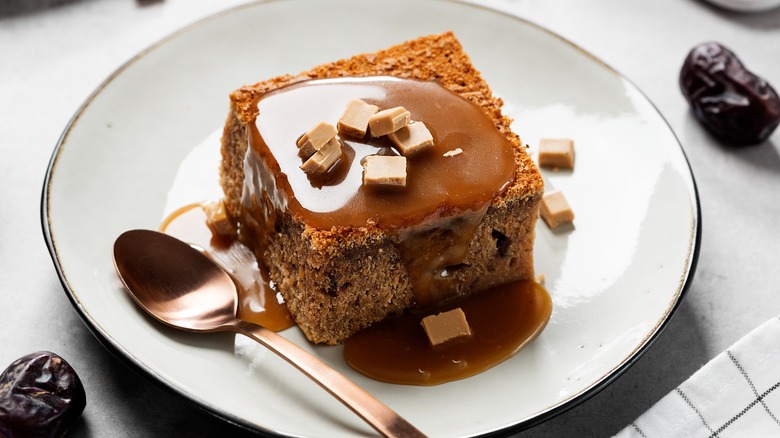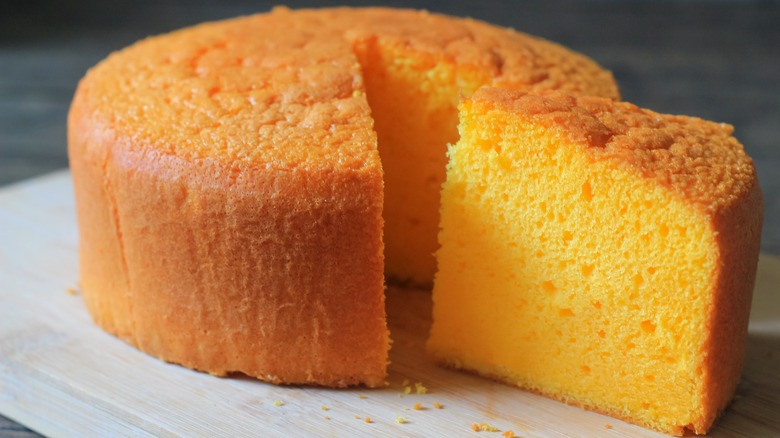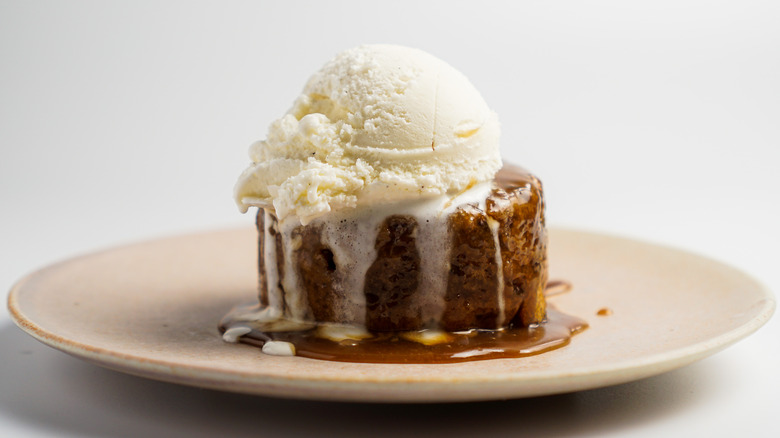What Kind Of Cake Do You Need For A Classic Sticky Toffee Pudding?
If you've never had sticky toffee pudding, you're missing out on one of the best desserts to ever come out of the United Kingdom. The genesis of this classic sweet treat's creation has been up for debate for decades, though it seems to have first gained popularity in England's Lake District before quickly spreading to other parts of the country — and then the world. Though thought to be about 60 years old, its exact origins remain a mystery; it's not clear when or where the dish was first prepared, but several inns and hotels, including the erstwhile Sharrow Bay Country House in Ullswater, have taken credit. Still, one thing is for certain — there are three main elements to the perfect sticky toffee pudding: Toffee sauce, dates, and sponge cake.
Recipes vary depending on who is in the kitchen, but the base of the dessert is always a soft, sponge-like cake, which soaks up the toffee sauce. Even Prue Leith's controversial version from "The Great British Bake Off," which featured a tuile garnish that scandalized some viewers, was otherwise by-the-book, with a "lovely, light sponge." On the show, the restaurateur and culinary personality was quick to note, "Of course, the sponge is the most important thing."
Why sponge cake makes the best sticky toffee pudding
Sponge cake's porous, squishy texture is what makes it perfect for absorbing the toffee sauce. While you could substitute something like angel food cake, it won't be considered a traditional recipe. Sponge cake differs from typical yellow cake in that, in the United States, it is made with more eggs and no butter. The texture comes from a folding process; rather than whisking or beating the batter, sponge cake's dry ingredients are folded into eggs that have been whipped. However, the British variation is a bit different, as it does contain butter. The recipe you follow might depend on where you're from, but this means that — even though banana sponge cake would make for a unique and compelling twist — the most time-honored sticky toffee puddings are made with the British version of a sponge cake.
Toffee sauce is classically used in this dish, though caramel can be substituted if needed. The main difference between toffee and caramel sauce is that toffee is made by heating butter and brown sugar, while caramel is made by heating butter and granulated sugar. Regardless of which sugar is used, to achieve the silkiest sauce, Prue Leith swears by giving the pan a swirl every now and then as the sugar caramelizes instead of stirring with a spatula. No one wants a gritty toffee sauce, which might not permeate the delicate sponge as seamlessly.
Tips for perfecting classic sticky toffee pudding
This delicious pudding comes together easily using basic ingredients, but there are touches that make it special. In order for the dessert to be as traditional as possible, the sponge cake needs to be loaded with finely chopped or pureed dates, which add a subtle sweetness. Then, there are all the different ways you can choose to marry the toffee sauce and sponge. Some chefs, like Gordon Ramsay, like baking the cake separately and save the saucing for plating. Prue Leith, meanwhile, prefers to add a spoonful of toffee to the bottom of her ramekins before pouring in the batter; she also drizzles the sweet stuff over each finished pudding prior to serving.
For an unrelentingly saucy rendition, sticky toffee pudding can even be layered. The cakes are baked, cooled, sliced in half, and then rebaked in a pool of sauce, yielding incredibly rich results. It starts with a Leith-like bottom layer of toffee; the first halves of the cakes are added and sauced, then the other halves are plonked on top and also sauced. Once out of the oven, you guessed it — more toffee sauce gets spooned on top.
To balance out all that caramelly richness, sticky toffee pudding is often served with whipped cream, though vanilla ice cream or crème anglaise are also common. Without one of these, the dessert could risk being a touch saccharine for the average palate, given how much sauce the signature sponge soaks up.


